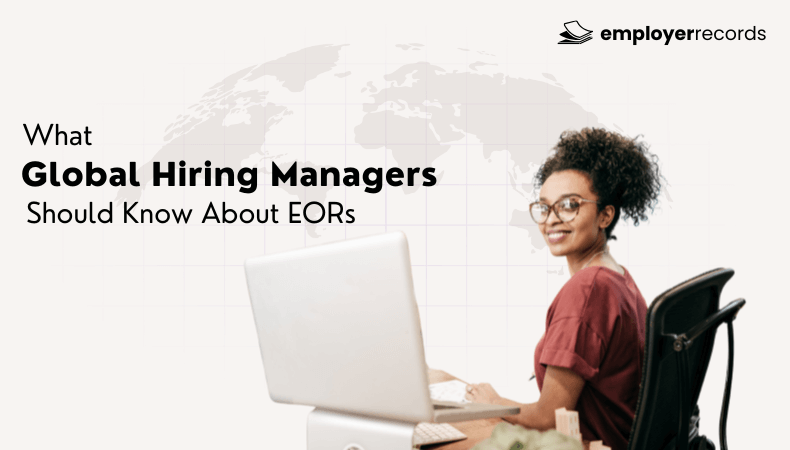Expanding teams across borders has become commonplace in today’s global economy, but international hiring brings complex challenges, from unfamiliar labor laws and taxes to time-consuming payroll and compliance processes.
An Employer of Record (EOR) service can simplify this by acting as the legal employer for your overseas workers. The EOR handles all local hiring paperwork, payroll, benefits, and regulatory compliance on your behalf, allowing your company to focus on core business needs.
This model has skyrocketed in popularity: according to industry reports, the global EOR market was $4.29 billion in 2023 and is projected to hit $6.6 billion by 2030. In short, EORs promise cost‑efficient, low‑hassle expansion into new markets.
However, outsourcing HR to an EOR is still an investment. To ensure that the benefits outweigh the fees, organizations must measure the return on investment (ROI) of their EOR partnership.
ROI in this context means quantifying how much value the EOR delivers (in cost savings, speed, risk reduction, etc.) compared to what you pay. Importantly, ROI isn’t guaranteed just by signing with an EOR.
In fact, as one industry guide notes, “EOR services promise cost efficiency… but ROI isn’t always guaranteed”. By defining clear metrics and tracking them, HR leaders and executives can turn a soft “it feels like savings” argument into hard data.
This helps justify the EOR decision, guides strategy and aligns the EOR’s performance with your financial and business goals.
What Are Employer Of Record (EOR) Services?
Employer of Record is essentially a third-party HR outsourcing partner that legally hires and manages employees on behalf of your company in a given country.
Unlike setting up a local subsidiary or entity, an EOR becomes the legal employer, handling nearly all workforce administration. This includes payroll processing, benefits administration, tax withholding, labor contracts, visas and permits, and even onboarding/offboarding paperwork.
In effect, the EOR assumes the employer’s regulatory obligations while you retain direction over the worker’s day-to-day tasks. For fast-moving companies, that means you can tap global talent “in days, not months,” without building infrastructure from scratch.
EORs typically maintain local compliance expertise and technology tools so that complicated rules (such as mandatory benefits or reporting deadlines) are managed correctly.
The result is a much cleaner way to expand internationally: you avoid huge entity‐setup costs (which Atlas HXM cites can exceed 85% of upfront investment) and transfer the risk of legal missteps to specialists.
In short, EORs simplify global hiring by “converting fixed legal infrastructure costs into flexible service-based costs” as your business grows.
Why Measure ROI Of EOR Services?
Deploying an EOR should be treated like any strategic investment. While the EOR model can unlock new revenue streams and efficiency, it also incurs fees, and it is not a magic wand.
To decide if and how much to use EOR services, executives need data on outcomes: did headcount grow profitably? Did costs drop or revenues rise? These questions tie directly into ROI analysis, which connects HR tactics to the company’s bottom line.
Measuring ROI forces transparency on two sides: the costs you pay (EOR fees, any internal change costs) and the benefits you gain (savings and productivity improvements). This ensures the decision is financially justified and highlights where the EOR truly adds value.
As one BPO industry source advises, evaluate any EOR partner with an “ROI lens” – ask for case studies, and quantify how their service speeds your time to market or cuts overhead. In summary, ROI measurement turns the EOR from a vague “nice-to-have” into a measurable business contributor.
Key ROI Metrics For EOR Services
To gauge EOR performance and ROI, focus on several core metrics. These metrics should be both quantitative (dollar savings, time measured, error counts) and qualitative (employee satisfaction, operational flexibility).
Together they capture the full picture of value. Below are the most critical ROI factors, each reflecting a key benefit area of EOR services:
Cost Savings
A primary draw of EORs is cost reduction. Compare your total costs with the EOR versus building an in-house HR/legal apparatus abroad. Key savings can come from avoiding fines and penalties, lower taxes through optimal structure, and reduced administrative overhead.
For example, an EOR’s expertise in local labor laws can help you dodge expensive compliance violations – one case notes German EORs (and their clients) may avoid fines up to €30,000 per infraction.
You also save on HR headcount: no need to hire full-time payroll specialists, compliance officers, or extra recruiters for each new country. Any reduction in hiring costs, severance claims, or benefits missteps all contribute here.
In practice, teams often compute cost savings by valuing the hours saved in HR and multiplying them by salaries, a strategy noted in HR outsourcing ROI models. Soft gains like avoiding state registration fees or leasing office space for HR staff can be significant when scaled globally.
Time-to-Hire And Speed to Market
EORs accelerate growth by cutting months out of the hiring process. With a ready-made legal entity in place, you can onboard new employees in days instead of months, greatly shortening time-to-hire and time-to-revenue.
This speed directly boosts ROI: faster hiring means projects start sooner and sales territories open earlier. Industry guides recommend tracking metrics like “time to hire” and “time to fill” for critical positions.
For example, one EOR partner highlights that using an international EOR lets you hire abroad almost immediately, skipping the local entity setup. Faster onboarding also reduces downtime costs: fewer weeks of vacant roles and less manager overhead.
In ROI terms, calculate the additional revenue gained from earlier market entry or projects underway, compared to delayed launches without an EOR.
Compliance Success And Risk Mitigation
One of the EOR’s core jobs is ensuring full legal compliance. Metrics here include compliance audit results, the number of compliance errors, or penalties avoided. You might track something like “compliance incident count” or “regulatory fines” before vs. after using an EOR.
A high compliance rate means the EOR is correctly managing local labor rules; as one performance metric guide notes, a top-tier EOR “reduces legal risks associated with international employment”.
Every infraction or paperwork mistake that’s prevented is essentially a cost avoided. For ROI, estimate what fines, back taxes, or legal fees would have cost if you did it wrong, and count them as part of your EOR benefit.
For perspective, laws vary – e.g. in Germany an unlicensed EOR can trigger heavy fines of up to €30k per violation. In addition, consider intangible risks: currency of regulation, litigation risk, and brand protection.
Lower risk means more stable operations and free cash that would otherwise be held for potential fines, all boosting your net return.
Employee Satisfaction And Retention
The EOR’s efficiency should translate into a better experience for employees, which in turn improves productivity and lowers turnover. Key measures include employee engagement scores, turnover/retention rates, and satisfaction surveys.
For example, because EORs typically administer local-market benefits and ensure accurate, timely pay, employees enjoy the “correct payment” and benefits they expect.
A smoothly handled onboarding (often an EOR responsibility) also leaves a great first impression; research shows that strong onboarding can improve retention by over 80%.
When staff are happier and stay longer, hiring and training costs fall. In ROI terms, quantify this by tracking turnover before and after EOR adoption and converting reduced attrition into dollars saved.
For instance, a company might calculate that each percent increase in retention saves recruitment costs of thousands.
Scalability And Agility
EORs inherently boost your ability to scale quickly and adjust to changes. A key question: How easily can you expand or shrink in a new country? Metrics might include “time to scale headcount up/down,” or a qualitative assessment of flexibility.
By using an EOR, you eliminate the fixed expense of maintaining idle subsidiaries; instead, you pay per employee as needed. The benefit is seen when market conditions shift: you can add 50 workers overnight for a big contract, or lay off staff without closing legal entities.
This agility is itself an ROI metric, you could, for example, track the speed and cost of expansion initiatives before vs. after EOR use. By reducing bureaucratic drag, EORs keep companies “lean” and growth-focused, which translates into more profitable scaling.
The table below summarizes these ROI metrics and what each indicates:
| ROI Metric | What It Measures / Indicates |
| Cost Savings | Total reduction in HR and compliance expenses (e.g. fewer fines/penalties, lower overhead, no entity setup). |
| Time-to-Hire & Market Entry Speed | How quickly new hires are onboarded and new markets are entered (often measured in days rather than months). |
| Compliance & Risk Mitigation | Effectiveness of meeting local laws (e.g. number of compliance errors or fines avoided), reflecting legal risk reduction. |
| Employee Satisfaction & Retention | Effectiveness of meeting local laws (e.g., number of compliance errors or fines avoided), reflecting legal risk reduction. |
| Scalability & Agility | Ease and speed of expanding or adjusting the workforce internationally, showing how flexibly you can grow without large fixed costs. |
Calculating ROI: Quantitative And Qualitative Approaches
With the metrics defined, the next step is the actual ROI calculation. The basic ROI formula applies:
ROI = (Total Benefits – Total Costs) / Total Costs × 100%
“Total Costs” includes all EOR fees and any related expenses you incur.
“Total Benefits” covers the dollar value of savings and gains.
For example, if outsourcing saves $200K in combined HR and compliance costs and you pay $100K to the EOR, ROI is (200K–100K)/100K = 100%.
Tangible Values
The hard part often lies in quantifying benefits, especially intangible ones. Start by listing all tangible values:
- HR Labor Savings: Calculate HR staff hours freed by outsourcing (e.g., payroll, benefits admin, compliance tasks) and multiply by their loaded labor rate. BCN Services shows how to value this: record hours before outsourcing, then use staff salaries to compute savings.
- Avoided Hiring Costs: If the EOR obviates the need to hire new HR or legal staff, include the salary and benefits you would have paid.
- Fines and Penalties Avoided: Estimate any historical or potential fines (using past incidents or industry averages) that were avoided by EOR compliance.
- Time-to-Revenue Gains: For accelerated market entry, estimate the incremental revenue gained from earlier launches. For instance, if you gain one extra month of sales in a new country because the EOR onboarded staff faster, multiply that month’s expected revenue.
- Recruiting Cost Reductions: Calculate savings in hiring expenses such as advertising, agency fees, relocation, and training, if the EOR’s services cut turnover or speed hiring.
Once you have these numbers, plug them into the formula. You can also calculate ROI on an annualized basis if comparing year-over-year changes.
Qualitative Factors
Equally important are the qualitative factors. These are benefits that don’t easily go on the balance sheet but add value:
- Risk Reduction: The peace of mind from no regulatory surprises can be critical. While hard to express in dollars, you should note compliance reliability, improved audit readiness, or better legal assurance in your analysis narrative.
- Strategic Focus: Freed-up management time (from not dealing with foreign HR minutiae) can be mentioned, as it allows focus on core business.
- Employee Morale: A happier remote workforce (due to smooth payroll and benefits) contributes indirectly to productivity. You might attach a multiplier (e.g., 5–10%) to workforce output as in employee engagement studies.
Include these qualitative improvements in your ROI discussion, even if you don’t ascribe a precise number. They often tip the decision in favor of continuing the EOR when the quantitative ROI looks marginal.
In practice, companies report that having an EOR can convert fixed costs into scalable costs, a flexible trade-off that, while intangible, underpins a more efficient P&L.
Best Practices For Maximizing EOR ROI
To make the ROI measurement meaningful, also focus on maximizing it. Here are some best practices:
01. Conduct A Thorough Cost-Benefit Analysis Up Front
Before signing with an EOR, list all expected costs (monthly fees, implementation effort) and all savings/gains (HR headcount reduction, compliance savings, speed benefits).
Be conservative in your estimates, and update them as real data comes in. This analysis not only projects ROI but also clarifies negotiation points.
02. Choose The Right EOR Partner
Not all EORs are equal. Evaluate candidates “with an ROI lens.” Check their track record in your target markets, and ask pointed questions: “How will you enable faster hiring ?” “Can you quantify how you will reduce our HR overhead?”.
Review case studies or references showing how they delivered value. Also, scrutinize pricing, ensure you understand which services are included, so there are no hidden fees eroding ROI.
You may check the list of top EOR solutions here.
03. Negotiate Value-Based Terms
Discuss flexible pricing or success-based components, especially if you expect large hires or rapid scaling. Many EORs will offer discounted rates at volume. Remember that a slightly higher fee might be acceptable if it covers valuable extras (like accelerated onboarding or enhanced support).
Align your contract to incentivize the outcomes you care about (e.g., penalty clauses for missed compliance targets or bonus hours for urgent hires).
04. Set Clear Goals And KPIs
From Day 1, define what success looks like and how you’ll measure it. Include the ROI metrics mentioned above in SLAs or review meetings.
For instance, agree on a target onboarding time or an error rate goal. Use dashboards or regular reports from the EOR to track these KPIs. Regular monitoring ensures you catch issues early and continuously improve the process.
05. Leverage Local Expertise Collaboratively
An EOR’s local knowledge is one of its biggest assets. Work with your EOR to tailor job postings to local culture and language, and ask for introductions to trusted recruiters in that market.
Customize onboarding and benefits according to local norms to improve employee acceptance. This collaboration not only speeds hiring but also enhances retention – a point underscored by guidance that culturally sensitive onboarding “maximizes your ROI”.
06. Use Technology And Process Integration
Many EORs offer tools (portals, mobile apps, compliance trackers) to simplify tasks. Integrate these into your HR systems so that data flows smoothly. Automated payroll and compliance checks reduce manual effort and errors. The time saved here should feed into your ROI calculation as well.
By applying these practices, you ensure the EOR is not a passive vendor but a strategic partner. The result is a virtuous cycle: clear goals and communication drive better results, which improve ROI, which in turn justifies deeper investment in the partnership.
Conclusion
In the age of borderless workforces, Employer of Record services are a powerful way to grow globally. But like any business investment, they must earn their keep. Measuring the ROI of an EOR requires looking beyond headline costs to all the efficiencies, speed gains, and risk reductions they deliver.
Track key indicators, cost savings, hiring speed, compliance success, employee retention, and scalability, and use them to compute ROI. Don’t forget the qualitative value: employee experience and strategic focus can be significant.
A disciplined ROI approach ensures that your EOR partnership is not just convenient but valuable. And by choosing the right provider, setting clear targets, and collaborating closely (for example, leveraging their local insights and tech), you can maximize those returns.
In the end, an EOR should not just manage risk and save time but actively contribute to your company’s growth and profitability.
With careful measurement and management, the decision-makers who deploy EOR services can demonstrate and continuously improve the positive impact on the organization’s bottom line.







